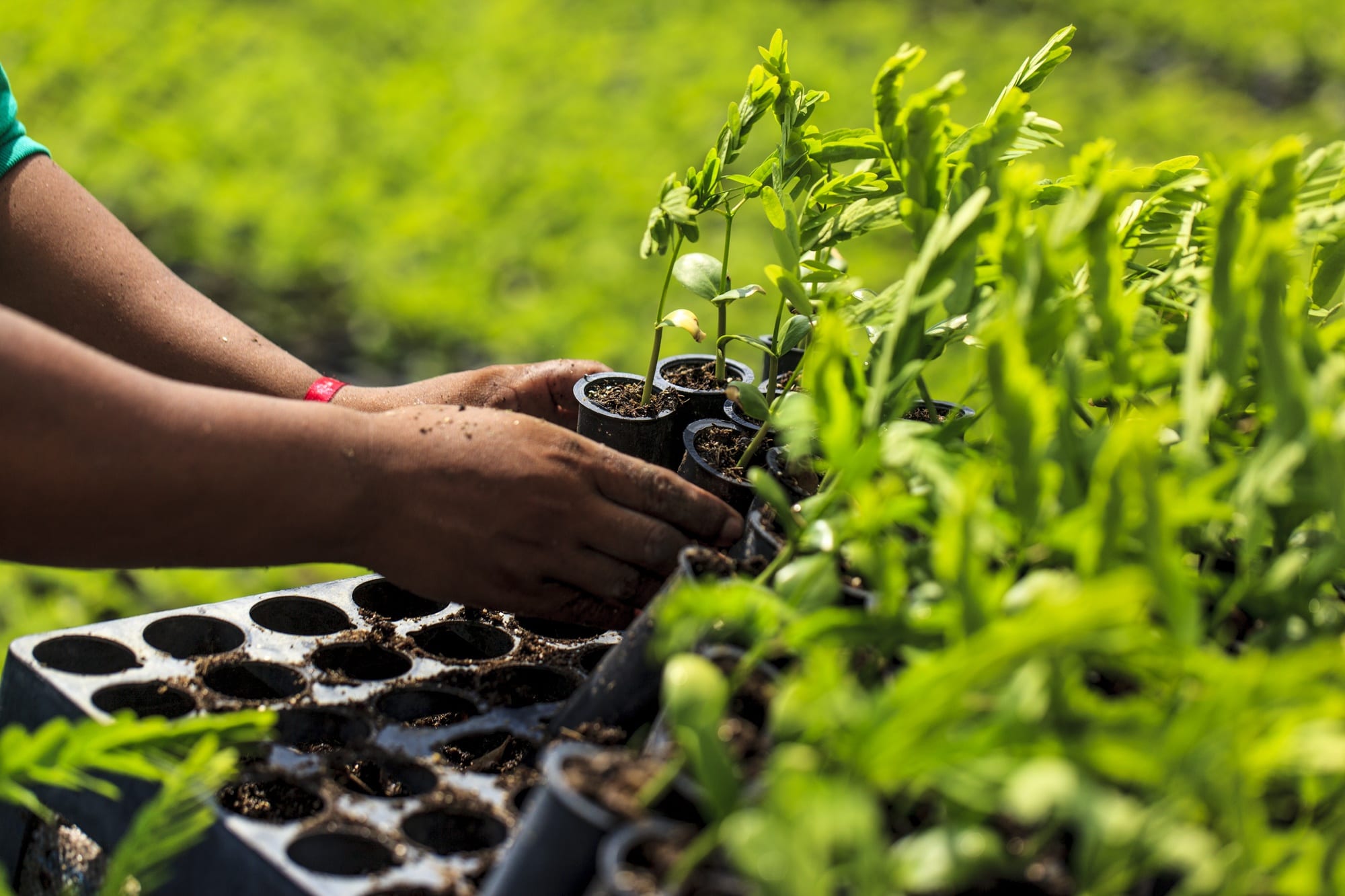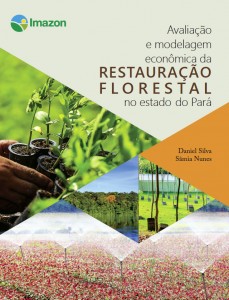



As part of its contribution to the global effort to mitigate climate change, the Brazilian government has announced a goal of 12 million hectares for restoration and reforestation by 2030. The state of Pará could contribute up to 25% of this target if it restores its forest deficit, estimated at 3 Mha. Of these 3 Mha, we estimate a deficit between 760 thousand ha and 1 Mha in Areas of Permanent Preservation (APP) and approximately 2.3 Mha in areas of Legal Reserve (LR). The estimated cost of restoring riparian APP and LR in Pará is BRL 7.7 billion to BRL 9.4 billion (BRL 2.5 billion to 4.4 billion in APP and BRL 5.2 billion to 6.9 billion in LR), over 22 years, at current values for the year 2015.
The opportunity cost of the land is estimated at between BRL 4.8 billion and BRL 5.3 billion, in addition to a reduction of more than 20% of the agriculture and livestock production area (between 5.3% and 7.5% in APP and 15.7% in LR). We did not consider the forest compensation for the deficits in the calculations (i.e. by acquiring a new area with forest surplus), since we do not have an estimate of the LR area that will be effectively compensated in the entire state.
The cost of forest restoration in Pará ranged from BRL 2,280 to BRL 11,243/ha (current values for 2015) depending on the method adopted (e.g., fencing the area, total planting (1,666 trees/ha), enrichment with seedlings). The uncertainties in the total restoration costs in this report are related to: i) lack of information about dimensions of the APP to be restored, which in turn depends on the advance and validation of the Rural Environmental Registry (CAR, in Portuguese), since the preservation area to be restored around rivers varies according to the size of the property; and ii) definition of the restoration method.
We estimated the potential gains from carbon credit at BRL 6.6 to BRL 7.4 billion (BRL 1.8 to 2.6 billion in APP and BRL 4.8 billion in LR), which would pay up to 92% of the implementation costs in the LR and up to 74% in APP. We calculated that up to 120 million tonnes of CO2 equivalent can be taken up per year (between 40.9 and 57.6 MtCO2 in APP and 62.8 MtCO2 in LR) with an annual restoration of up to 232 thousand ha of forest (between 84 thousand and 119 thousand ha in APP and 113 thousand ha in LR). Brazilian environmental law at federal level has determined 20 years for restoration or compensation of forest deficits, but the state regulations demand that APP restoration be completed in nine years. However, mechanisms to capture financial resources and regulations that guarantee legal certainty for the investors and beneficiaries of carbon credit are both lacking.
Sustainable forest management (legal logging) in 50% of LR was evaluated as the second source of direct financial benefits from restoration, and this activity showed returns that are competitive with agriculture and livestock production. The annualized Net Present Value (ANPV) of the native species evaluated was: BRL -319/ha (negative) for cumaru (Dipteryx alata); BRL 2,110/ha for marupá (Simarouba amara); BRL 453/ha for sucupira (Bowdichia virgilioides); BRL 962/ha (negative) for cedar (Cedrela fissilis); BRL – 58/ha (negative) for copaiba (Copaifera langsdorffii); and BRL 1,316 for paricá (Schizolobium amazonicum). Two species showed competitiveness with agriculture and livestock activities with a financial risk below 1%: marupá and paricá – species with a more rapid exploitation cycle. Despite the financial return, it is not feasible to expect forestry management practices throughout the entire LR area to be restored, due to low liquidity and unfair competition from illegal logging. The barriers to large-scale restoration and logging in the LR are similar: little knowledge of adequate planting techniques for restoration and exploitation of these areas; high cost of native seedlings and production inputs; little effective demand for restoration; and shortages of skilled labor.
We emphasize that the LR deficit should not be solved only through restoration, since part of this forest deficit may be offset by forest areas outside the property, reducing the total cost of large-scale restoration. However, there are no regulations and incentives for the marketing of these surpluses (e.g. via the Environmental Reserve Quota (CRA) market).
The use of Agroforestry Systems (AFS) can make restoration feasible for smallholders, according to our review of the literature. AFS have an average return of BRL 2,000/ha. However, intensive use of labor hinders the large-scale adoption of these systems. Furthermore, we do not know to what extent AFS will be implemented, since they are a legal option that can be adopted for any rural property, even if they are more commonly used in small properties. Thus, to estimate AFS revenues in this report, we extrapolated net revenue (in present value) only for the environmental deficit areas of small properties, resulting in a potential return of BRL 446 million per year.
As an indicator of the effectiveness of restoration, we evaluated the habitat availability to fauna in three scenarios, with and without restoration. The western region presented the greatest habitat availability. The west also shows the greatest combination of threats to habitat loss: deforestation driven by the growth of soybean production; infrastructure investments such as the BR-163; the Tapajós hydropower complex; and the port for distributing agricultural products (e.g. soybean). As most of the municipalities show a similar habitat increase by restoration (<5%), we suggest prioritizing the restoration in those areas with an intermediate amount of habitat availability (between 20% and 50%), but with a higher habitat gain. In this case, the most prominent were the municipalities located in the central-south region, such as Altamira, Novo Progresso and São Félix do Xingu. APP restoration increases habitat availability at a high financial cost, estimated approximately as a 1% gain in habitat availability for each BRL 1 million spent on restoration.
Below, we present recommendations to facilitate large-scale restoration in the state of Pará, first, to the restoration supply chain: i) invest in Research and Development (R & D) for the production of native species; ii) structure the value chain for commercialization and valorization of the products from restored areas; and iii) establish a state strategy for restoration, starting with the mapping of conservation priority areas and coordinating actions with the agricultural sector. In addition to these direct actions, it is also necessary to promote some public policies to support the restoration, such as: i) validation of the CAR and monitoring compliance with the Forest Code, so that the demand for restoration may be realized; ii) the establishment of a strategy for forest credit within the Low Carbon Agriculture plan (ABC – Agricultura de Baixo Carbono, in Portuguese) and other financial support mechanisms; and iii) implementation of restoration incentive mechanisms for landowners and settlers because, despite the forest deficits, landowners have not sought restoration.
Download
This post was published on 6 de June de 2017
Several authors. System for Monitoring Timber Harvesting (Simex): Mapping of logging in the Brazilian Amazon…
Souza Jr, Carlos M; Marengo, José; Ferreira, Bruno; Ribeiro, Júlia; Schirmbeck, Lucimara W; Schirmbeck, Juliano;…
Several authors. System for Monitoring Timber Harvesting (Simex): Mapping logging in Amazonas State – August…
Several authors. System for Monitoring Timber Harvesting (Simex): Mapping logging in Roraima State – August…
Several authors. System for Monitoring Timber Harvesting (Simex): Mapping logging in Amapá State – August…
Several authors. System for Monitoring Timber Harvesting (Simex): Mapping logging in Pará State - August…